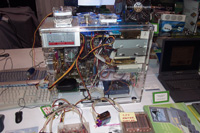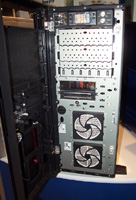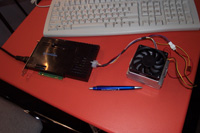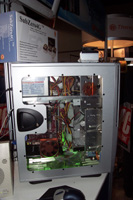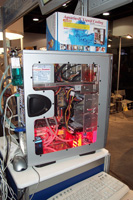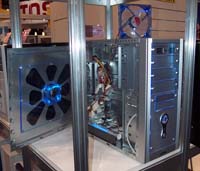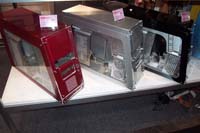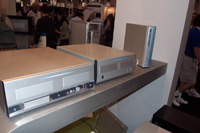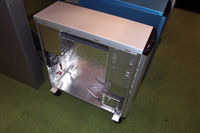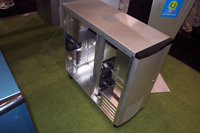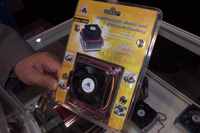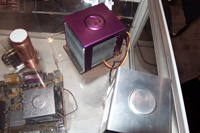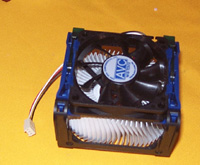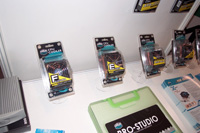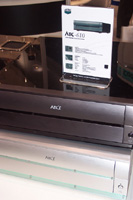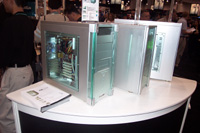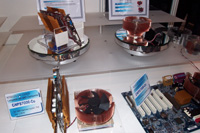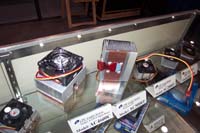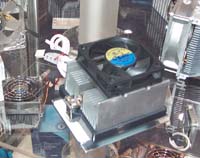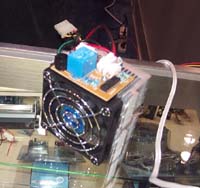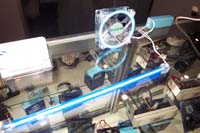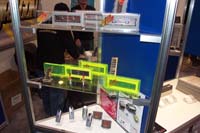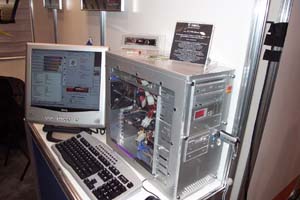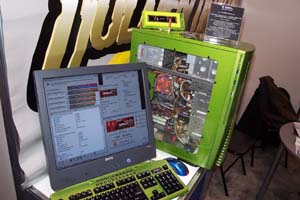
Original Link: https://www.anandtech.com/show/1039
Comdex 2002 - New Meaning To The 'Cold Show'
by Kristopher Kubicki on November 21, 2002 4:19 AM EST- Posted in
- Cases/Cooling/PSUs
We took a first look at the large array of cooling and case companies at Comdex in the newsletter posted on Monday. Since cooling and case manufacturing seemed to be very prevalent on the floor, we have taken the time to provide a large degree of coverage of both of these markets. To follow up our newsletter article, we continued to take a look at new cooling technology on the floor, and even revisited a few places we had already been. Interestingly enough, there were several large cooling and case companies not on the floor including Vantec, Chenming and Antec.
We mentioned in the newsletter that the number of vendors on the floor was less than half of two years ago. There is still a large presence of the absent companies, but they have opted to rent hotel suites and rooms off the show floor instead. Since it has become a real financial drain on some companies, a lot of big names are unable to justify the 72 dollars per square foot for a booth. However, for many small companies this is one of the few times of the year they will be able to make a name for themselves and increase their product awareness. Interestingly enough, these small fish are also the vendors that seem to have the new and unconventional technology, particularly in cooling and case technology. Get ready for our thorough breakdown of this year’s C&C analysis of new products on the floor!
ThermalTake
Our journey began with the largest non-OEM cooling company, ThermalTake. We took a look at ThermalTake’s Xaser II case several months ago and we were pleased with its variation of the Chenming server tower design. ThermalTake was very excited to show us their new case, the Xaser III, which came with several advantages over the Xaser II case. Most noticeable was the evolved LCD display on the top of the case which also provided control for up to four individual fans.
Even more interesting was the replacement of the lock, which we had several issues with when we reviewed the case. The lock now provides three levels of security; the first being the ability to lock just the case door, the next level locking off the entire front panel, and then the third level locking both. We liked that the entire front panel on hinges so the filters on the two intakes can be changed without removing any internal components.
Two more "new" products ThermalTake had to show off included their new SubZero4G peltier cooler. The idea of peltier cooling is hardly new, but the problems plaguing peltiers today revolve around their generation of condensation. ThermalTake, with the help of ActiveCool solved this problem by using a PCI adaptor to control the partier’s degree of cooling based on the dew point in that particular condition. ActiveCool boasts the new 4G peltier is capable of cooling both K7 and K8 processors down to 26C while operating around 28dBA.
The PCI card has an onboard microprocessor and thermometers to detect miniscule changes in atmosphere pressure, temperature, and humidity. This way, the PCI card never lets the peltier get below the dew point of the particular environment and no condensation is created. We are slightly wary of this technology, but if it proves to be stable and reliable, ActiveCool/ThermalTake might be taking a step in a relatively inexpensive cooling.
ThermalTake’s second new technology demonstration was their Aquarius II water cooling kit. Unfortunately, ThermalTake was not running the unit on a functional PC, but we were able to get a quick picture of the unit while it was in demonstration mode.
While ThermalTake still can not compare itself on the level of quality with a company like Swiftech, they are doing a fair amount of research which could put themselves in interesting new places. Their marketing campaign has already done great things for them; once we are able to obtain some of these new cases and active cooling designs we will thoroughly put them to the test and see if they are in fact worth the hype.
Enermax & Lian Li
We spent two days browsing the Enermax/Max Point booth while at Comdex. Like ThermalTake, Enermax had a fairly large booth with a wide assortment of different aftermarket products. The product that seemed to impress the audience the most was their new case, the CS-5190AL. In direct Lian Li fashion, this case comes in all aluminum with an acrylic bezel, but slants the top portion of the face inward. Also provided is an LCD readout of case and CPU temperature. We will be reviewing one of these cases in the next few weeks, so time will tell if this new, unusual looking case can compete with what else is on the market.
We were able to take a quick look at some of their other new products, which include 120mm LED fans, LCD controls (similar to the Vantec Nexus), and half a dozen new power supplies.
Lian Li’s booth was situated directly across from Cooler Master, so the tension between the two aluminum giants was definitely intense. Lian Li took the time to show us their new products, including two new small form factor cases. The case in the center, the PC-9300 has already been available for a while, and we will be posting a review of it soon.
Lian Li also showed us two huge aluminum cases which they did not have specifications for. Both of these giants have the trademark Lian Li carbon fiber along the external corners. From our observations, it looked like the larger of these two cases was significantly bigger than that of a Chenming tower. Hopefully, we will be able to obtain a sample of these two behemoths in upcoming months.
Glacial, AVC & Auras
Drifting through the
Further down the
One of the more exciting HSF combos on the floor was AVC’s new unit, the Sunflower. As a joint venture with Intel and AVC, the Sunflower looks most like an Orb heatsink with a large winghead fan on top. Unfortunately, specifications seemed to be nonexistent on the floor, but we were told the Sunflower was capable of 36CFM of airflow. Certainly impressive, but if the Sunflower runs at 40dBA it will probably not become a very mainstream HSF combo.
Cooler Master
Cooler Master was very eager to see us and insisted on showing us their retail and OEM solutions. The first products shown to us were their HSF combos. Cooler Master has a wide variety of different product lines, but none of the products they had on display were significantly different than the products they currently have available.
Cooler Master also demonstrated their new desktop rather than tower design, the ATC-610. Cooler Master has gained a large amount of popularity with their ATC desktop case line, and other case companies are following suit with their own desktop cases including Lian Li.
The ATC-210 is CM’s newest aluminum tower. There does not seem to be anything particularly exciting about this case either. CM looks like they are playing catch-up with the other case manufacturers; let us see if they can still compete a few months down the road.
Zalman
While cruising along, we stopped by a personal favorite, Zalman. The Korean HSF company has poured a significant amount of money into research and development lately, so we were very anxious to see some of the new products they were working on. First on their list of products they demonstrated was the 400W PSU based on their same technology packages as the 300W PSU’s available now. Zalman has lost a lot of ground against the big PSU manufacturers because they did not have a high output solution.
More exciting was their new HSF combo, which is universal for both K8 and Pentium 4 processors. We were given a few early specifications on this HSF, and we were impressed with the demonstration given to us on the floor. The CNPS7000-Cu weighs in at 775g and is almost entirely copper. Even more impressive was the fan which never peaked over 32dBA, but on average ran around 26dBA.
What is the selling point on these heatsinks? They are capable of running at 0.20C/W. Currently, this is the lowest thermal resistance we have seen on a P4 or a K8 solution for cooling. We will be very excited to get our hands on one of these HSF combos in the upcoming months. Also visible in the bottom left of the image is a fanless Radeon 9700 heatsink. One Radeon 9700 manufacturer, Sapphire, is pursuing Zalman’s fanless solution (which runs the GPU 5 degrees Celsius cooler than the OEM ATI fan) so expect to see it available on multiple cards in the future.
While browsing the HSF OEM manufacturers, we stumbled across Ascent. Ascent made went through particular lengths to show us their new design on all of their CPU coolers which employs four holes at the bottom of the HSF for cooling. The idea is that the copper insert still makes contact with the core of the processor, but more cool air is allowed to circulate throughout the unit. If this sort of technology proves efficient and useful, we will most likely see it in new HSF combos in the future.
A second interesting HSF company we saw on the floor was Speeze/Spire. Spire, which is also known as The Fanner Group, had several interesting products in their booth which they were very proud to announce were all manufactured by themselves. As you probably know, the majority of case, cooling and power supply companies outsource and rebrand other products as theirs. The long run disadvantage of such practice usually leads to high costs and not always the best quality. Spire was very pleased to show off their new K8 HSF, but could not disclose any specifications on the product.
Even more interesting was the peltier cooler Spire had on display. Whereas ThermalTake/ActiveCool have decided to use a large PCI card to control their partier's temperature, Spire is working on a small chipset right on the heat sink. While still an early prototype, they were happy to let us take a picture as seen below.
Spire also had some new cold cathode tubes and fans which can be seen below. These cathode tubed fans really look like they can give the often dim LED fans a good run for their money.
GeIL & OCSystem
When we saw GeIL on the floor, we saw a much different booth than expected. Interestingly enough, they shared their booth with the online reseller OCSystem. To many of our readers, simply hearing the name OCSystem makes them cringe. However, it looks as if there are new changes in the company, and their approach to reselling.
Interesting to see was the amount of stress GeIL put on overclocking. We do not typically see a vendor want to let the end user push a product beyond its advertised limits. Judging by the number of heat spreaders and thermal pastes in GeIL’s booth, the choice to overclock looks to be encouraged by the GeIL crowd. For those of you not familiar with GeIL, they are a memory vendor that typically uses Samsung chips on their modules.
So how does OCSystem fit in? GeIL actually provides OCSystem with the majority of their memory. Although hard to see, the monitors below demonstrate two of OCSystem’s 3DMarks.
As we see more GeIL in the mainstream market, we will be able of tell if their quality has increased over the last several months.
Conclusion
We covered a lot of ground on the floor over the last two days. The C&C market definitely made its presence felt at this year’s Comdex, and hopefully can continue to innovate and stay competitive. Even though we have seen a smaller turnout and smaller vendors on the floor, there still have been a fair amount of quality demonstrations and products at this year’s Comdex.
This year’s new products proved to be exciting and innovative, particularly along the lines of heat sink technology. Great leaps are being made in quieter and cooler products. We will be doing our best to bring these new products to reviews in the next couple months, so do not hesitate to let us know in the forums or over email which products you think we should pursue the most!

